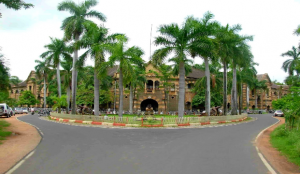Introduction

The Nagpur Divisional Commissioner’s Office is dedicated to efficient, transparent, and citizen-centric governance. This website serves as a one-stop platform for accessing key information on revenue administration, Zilla Parishad governance, and municipal administration across the division.
In addition to government services, we provide insights into agriculture, industry, tourism, and other key sectors. Regular updates ensure accuracy and relevance.
We welcome your feedback to enhance this initiative.
The Nagpur Divisional Commissioner’s Office serves as the administrative headquarters for Nagpur Division, playing a crucial role in coordinating and overseeing governance across all its districts. This office ensures effective implementation of government policies, public welfare schemes, and legal frameworks while maintaining seamless coordination between various government departments.
This website has been designed to provide transparent, accessible, and up-to-date information about revenue administration, Zilla Parishad governance, municipal administration, and key economic sectors such as agriculture, industry, and tourism. It aims to serve as a one-stop digital resource for citizens, government officials, and stakeholders, ensuring easy access to important notifications, government schemes, forms, and procedural guidelines.
Historical Significance
In the year 1861, the Sagar Narmada Territories and the territory of Chhattisgarh were merged to form Madhya Pradesh. In the year 1903, Warhad province was annexed from the Nizam and named as Central Province and Warhad (C.P. and Berar). The same name was in circulation till 1947. Madhya Pradesh Legislative Council was created on 8th November 1993. The construction of this grand and beautiful structure was completed as the Secretariat of Madhya Pradesh between 1910 and 1916. Currently this building is known as Old Secretariat. The building is an octagonal two-storied building with a total area of 8122.76 square meters. Black basalt and yellowish sand stone have been used for the outer walls of this building and these stones have been decorated with beautiful carvings. Bricks have been mixed in lime for the inner walls. The roof of the first floor of the building is Trafford asbestos sheet and the ground floor has a Madras pattern arch roof. An expenditure of Rs. 10,80,033/- has been incurred for the construction of this building. At present, apart from the divisional offices, 26 divisional and state level offices are functioning in this historical heritage area.
Nagpur Division is one of the six administrative divisions in the state of Maharashtra, India. It is located in the central part of the state and consists of several districts. Nagpur Division plays an important role in the state’s governance, administration, and economic development.
Districts in Nagpur Division: Nagpur, Wardha, Bhandara, Gondia, Chandrapur, Gadchiroli
Geography: Nagpur Division lies in a region that is largely composed of forested areas, particularly in districts like Chandrapur and Gadchiroli, which are rich in natural resources.
Economy: The region’s economy is driven by agriculture, industry, and mining. Nagpur is a major center for the trade of oranges, cotton, and soybeans. It’s also home to several industries including those related to manufacturing, education, and information technology.
Agriculture: Known for its production of oranges, cotton, and soybeans.
Manufacturing: Home to various industries, including manufacturing, textiles, and auto parts.
IT and Education: With its increasing role in IT, education, and healthcare, Nagpur is becoming an important educational and business hub in central India.
Culture: Nagpur Division has a rich cultural heritage, with historical landmarks, temples, and various traditional festivals celebrated across its districts.
Nagpur Division plays an essential role in the administrative setup of Maharashtra, contributing to the state’s overall growth and development.



